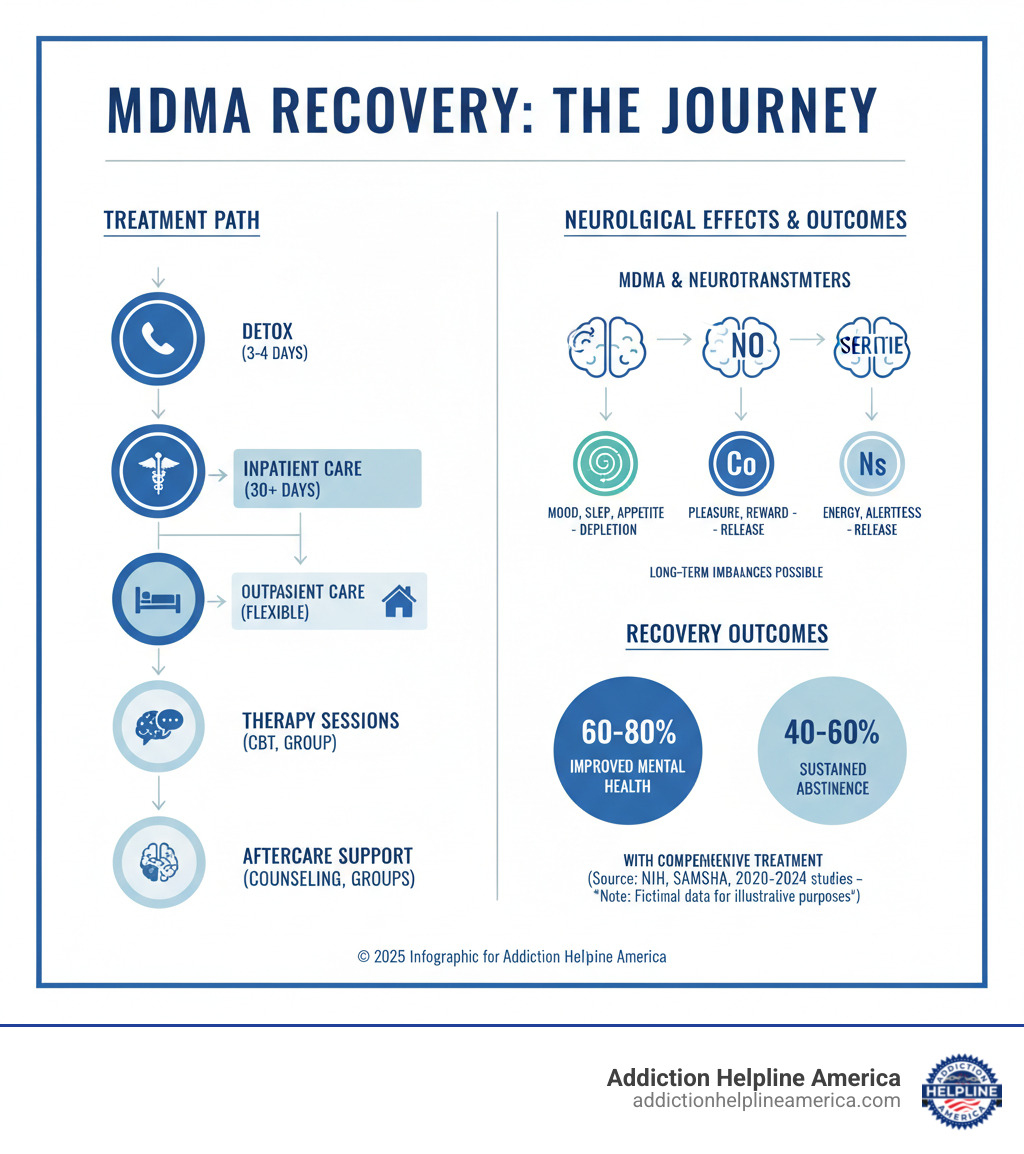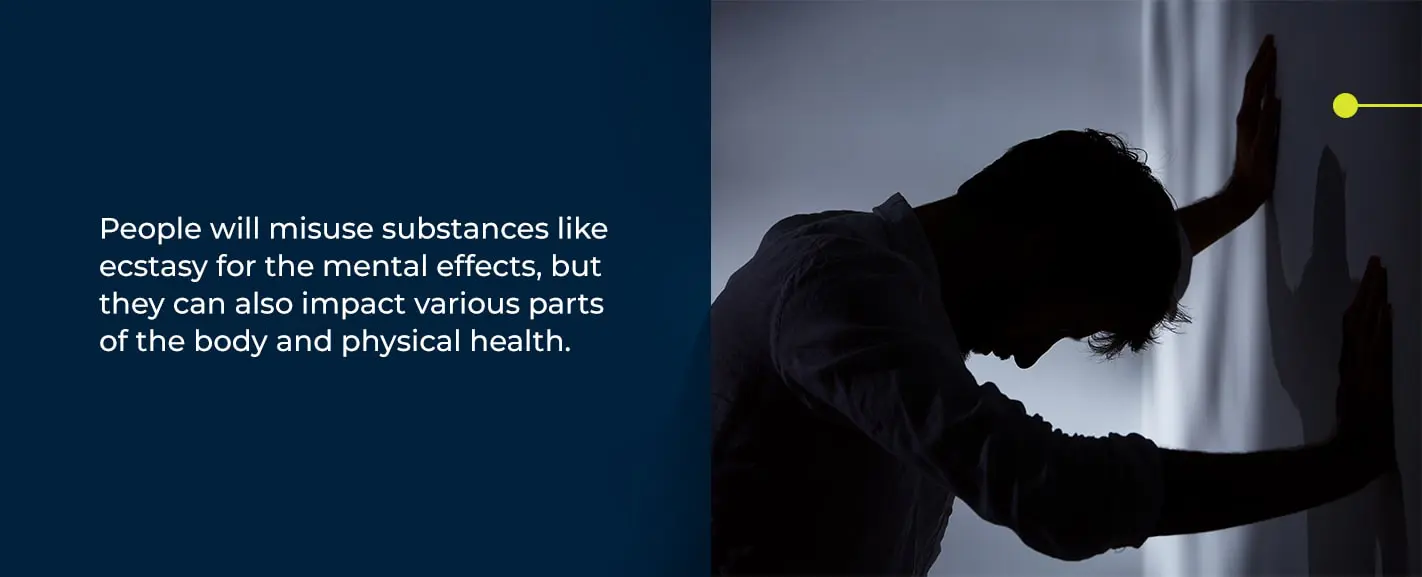Your Journey to a Healthier Life Starts Here
Free Insurance Verification
Verify Your Treatment Coverage
Verify Your Treatment Coverage
Ecstasy Treatment involves a comprehensive approach to recovery that typically includes medically supervised detoxification, behavioral therapy, and ongoing support to address both the physical and psychological aspects of MDMA addiction.
Quick Overview of Ecstasy Treatment Options:
If you or a loved one is struggling with MDMA use—also known as Ecstasy or Molly—you are not alone. In 2020, 2.6 million people aged 12 or older reported using ecstasy in the past year. While this synthetic drug is often associated with party scenes, its impact on your life can be devastating.
The good news? Recovery is possible.
MDMA alters brain chemistry, posing serious short-term and long-term health risks, from dangerous spikes in body temperature to lasting damage to memory and mood. Understanding these risks and knowing where to find help is the first step toward taking your life back. This guide covers what MDMA does to your body, the signs of addiction, available treatment options, and how to start the recovery process.
At Addiction Helpline America, our experienced specialists have helped thousands find recovery from Ecstasy addiction. We provide 24/7 confidential support and personalized referrals, guiding you through the process of finding a treatment program that fits your unique needs.

Before discussing Ecstasy Treatment, it helps to understand 3,4-methylenedioxymethamphetamine (MDMA). This synthetic drug, first created in 1912, acts as both a stimulant and a hallucinogen. Popular at raves, nightclubs, and music festivals, its promised euphoria hides serious risks to your brain and body.
Known by street names like Molly, XTC, E, or beans, MDMA is often sold as a “pure” crystalline powder, but this is rarely true. Most illicit MDMA is contaminated with other substances.
Effects begin within 30-45 minutes and last three to six hours. Users feel intense euphoria, a surge of energy, and heightened empathy. These feelings occur because MDMA floods the brain with neurotransmitters like serotonin, dopamine, and norepinephrine. However, this high comes with immediate consequences, including:
For a deeper look, explore the science behind MDMA’s effects.
Regular MDMA use can cause lasting cognitive impairment, particularly with memory and concentration. It damages serotonin-transmitting neurons, increasing the risk for chronic depression, anxiety, and other mental health disorders.
Research shows MDMA has significant addictive potential. Many users report classic signs of a Substance Use Disorder, including tolerance (needing more to get the same effect), withdrawal symptoms, and intense cravings. The brain adapts to the drug, making it difficult to feel normal without it. Learn more from research on MDMA’s neurotoxicity.

Take the first step towards a healthier life! Call now to connect with our compassionate team and start your recovery journey today. Your path to healing awaits!
Our recovery specialists are available 24/7 to provide support, and all calls are confidential and free. Reach out anytime – we’re here to help!
The illicit drug market is unregulated, and MDMA is often cut with dangerous substances like methamphetamine, synthetic cathinones (bath salts), or deadly fentanyl. A fentanyl-laced pill can cause a fatal overdose, making every use a life-threatening gamble.
For pregnant women, MDMA use during pregnancy is linked to birth defects and motor developmental delays in infants. It can also be toxic to the fetus, potentially causing miscarriage. If you or someone you know is struggling, effective Ecstasy Treatment is available.

According to the DSM-5 criteria for Substance Use Disorder, several patterns indicate a problem with MDMA. Experiencing even a few of these can signal it’s time to seek professional support:
Other behavioral signs can include increased irritability, social isolation, financial or legal troubles, and persistent mood swings or depression. These all point to a pattern that requires professional Ecstasy Treatment.
When you stop using MDMA, your brain needs time to rebalance. The withdrawal process is primarily psychological, but the symptoms can be debilitating and make quitting alone extremely difficult. Common symptoms include:
The crash that occurs a few days after use, sometimes called “Suicide Tuesday,” is due to severe serotonin depletion and can cause profound depression. These symptoms are not a sign of weakness, but a signal that your brain needs help. At Addiction Helpline America, we can connect you with programs that provide the medical and psychological support needed to get through withdrawal safely.

Recovery from MDMA addiction is possible with the right support. Ecstasy Treatment programs offer a continuum of care designed to meet your unique needs. Let’s walk through the typical steps of this journey.
The first step is medical detoxification, where your body clears itself of MDMA in a safe, supervised environment. While MDMA withdrawal is mainly psychological, the depression, anxiety, and fatigue can be overwhelming.
Detox typically takes three to four days. Medical staff monitor you 24/7 to manage symptoms and ensure your safety. They may recommend antidepressants or other medications to ease the emotional crash. This professional oversight makes the process more comfortable and significantly reduces the risk of relapse.
After detox, you’ll choose an ongoing level of care based on addiction severity, co-occurring mental health issues, and your home environment.
Integrated treatment for co-occurring disorders, like depression or anxiety, is crucial for lasting recovery.
Detox clears your body, but therapy heals your mind. Behavioral therapies are the foundation of effective Ecstasy Treatment, addressing the root causes of use.
Recovery isn’t just about stopping drug use; it’s about building a fulfilling life. At Addiction Helpline America, we offer free, confidential support to help you find a program that fits your unique needs. You don’t have to figure this out alone—we’re here to help, 24/7.

Take the first step towards a healthier life! Call now to connect with our compassionate team and start your recovery journey today. Your path to healing awaits!
Our recovery specialists are available 24/7 to provide support, and all calls are confidential and free. Reach out anytime – we’re here to help!
Ecstasy Treatment is a comprehensive process that combines medically supervised detox, evidence-based therapy, and ongoing support to address both the physical and psychological aspects of MDMA (Ecstasy/Molly) use.
If you or a loved one is struggling, recovery is possible. This guide outlines key risks, how to recognize a problem, and the core treatment paths so you can take confident next steps. Addiction Helpline America offers free, confidential guidance and personalized referrals to programs that fit your needs.
Ecstasy (MDMA) is a synthetic psychoactive drug with stimulant and hallucinogenic effects. Often sold as Molly or Ecstasy, it is frequently adulterated and rarely pure.
MDMA increases levels of serotonin, dopamine, and norepinephrine, creating euphoria, energy, and empathy but also immediate risks like hyperthermia, dehydration, increased heart rate and blood pressure, jaw clenching, anxiety, and, in severe cases, seizures.
Repeated use is linked to cognitive impairment, mood problems, and features of Substance Use Disorder. The unregulated market adds serious danger: pills/powder may contain methamphetamine, synthetic cathinones, or fentanyl. MDMA use during pregnancy is associated with birth defects and developmental delays.
For a deeper scientific overview, see the section above on MDMA’s effects and associated risks.
Identifying an MDMA-related Substance Use Disorder can be challenging. Common red flags include:
Withdrawal is primarily psychological and may include fatigue, depression, anxiety, insomnia, irritability, poor concentration, appetite changes, and panic. If these signs resonate, professional help can make a crucial difference.

Recovery is a step-by-step process that starts with safety and builds lasting skills.
Addiction Helpline America can help you choose a level of care that fits your situation and supports long-term recovery.
Ecstasy (MDMA) increases serotonin, dopamine, and norepinephrine, producing euphoria and empathy alongside risks like overheating, dehydration, liftd heart rate, nausea, anxiety, and, in severe cases, seizures.
Longer-term use is associated with cognitive issues and mood disturbances. Because the illicit market is unregulated, MDMA is often contaminated with substances such as synthetic cathinones or fentanyl, raising overdose risk. MDMA use during pregnancy is linked to birth defects and developmental delays. See the detailed section above for science-backed references.

MDMA addiction can look like escalating use, cravings, neglecting responsibilities, and continuing despite harm. Tolerance and withdrawal are common.
Withdrawal symptoms are mainly psychological: fatigue, low mood, anxiety, poor sleep, irritability, concentration problems, appetite changes, and panic. If you see these patterns, professional Ecstasy Treatment can help you stabilize and heal.
A practical path to recovery typically includes:
Addiction Helpline America provides free, confidential guidance to match you with programs that align with your needs and goals.
Are you or a loved one struggling with addiction? Call today to speak to a treatment expert.
Calls to any general helpline will be answered or returned by one of the treatment providers listed, each of which is a paid advertiser:
Our helpline is available 24 hours a day, 7 days a week at no cost to you and with no obligation for you to enter into treatment. We are committed to providing support and guidance whenever you need it.
In some cases, Addiction Helpline America charges our verified partner a modest cost per call. This fee helps us cover the costs of building and maintaining our website, ensuring that we can continue to offer this valuable service to those in need.
Calls to the general helpline will be answered or returned by one of the listed treatment providers, all of whom are paid advertisers.
By using the helpline, you agree to the terms of use. We do not earn any commission or fee based on the treatment provider selected by the caller, and there is no obligation to pursue treatment.
This service is not affiliated with Alcoholics Anonymous World Services, Inc.